Analyzing CRM's Impact on Customer Retention: Banks in India
VerifiedAdded on 2020/12/18
|8
|2079
|258
Report
AI Summary
This report examines the impact of Customer Relationship Management (CRM) on customer retention within the Indian banking sector. It begins with background information and a literature review, highlighting the importance of CRM in managing customer interactions and driving sales. The report identifies the problem statement as the need to understand how CRM affects customer retention, and it outlines research objectives and questions focused on the value, benefits, and importance of CRM in Indian banks. The significance of the study is emphasized by the benefits CRM offers to firms, including improved customer retention and business process management. The methodology section details the research philosophy, approach, design, data collection methods (primary and secondary), and data analysis techniques. It also describes the sampling strategy, validity, reliability, and ethical considerations. A proposed timeline/milestones section provides a schedule for completing the research. The report concludes with a comprehensive list of references, including books, journals, and online resources.
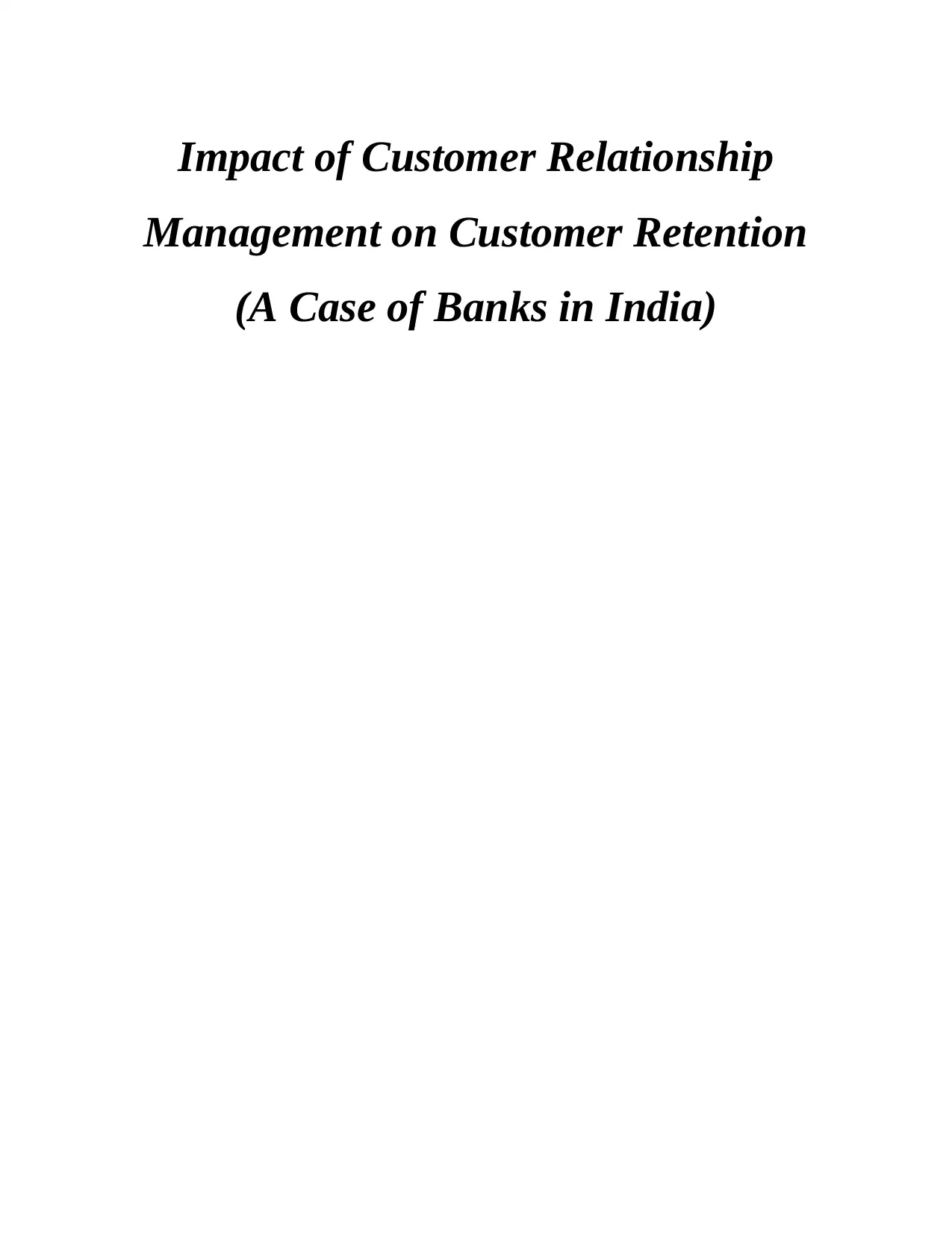
Impact of Customer Relationship
Management on Customer Retention
(A Case of Banks in India)
Management on Customer Retention
(A Case of Banks in India)
Paraphrase This Document
Need a fresh take? Get an instant paraphrase of this document with our AI Paraphraser
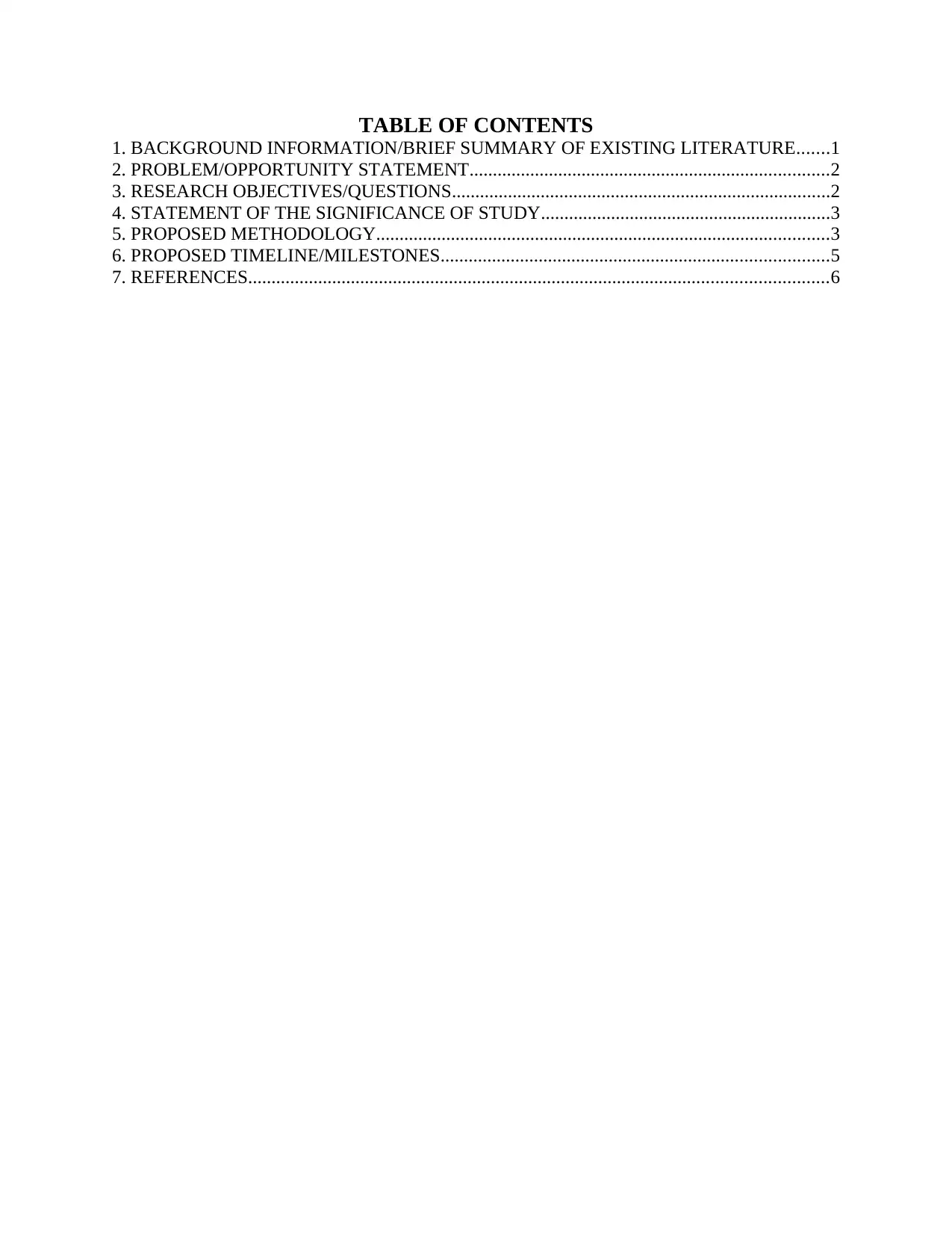
TABLE OF CONTENTS
1. BACKGROUND INFORMATION/BRIEF SUMMARY OF EXISTING LITERATURE.......1
2. PROBLEM/OPPORTUNITY STATEMENT.............................................................................2
3. RESEARCH OBJECTIVES/QUESTIONS.................................................................................2
4. STATEMENT OF THE SIGNIFICANCE OF STUDY..............................................................3
5. PROPOSED METHODOLOGY.................................................................................................3
6. PROPOSED TIMELINE/MILESTONES...................................................................................5
7. REFERENCES............................................................................................................................6
1. BACKGROUND INFORMATION/BRIEF SUMMARY OF EXISTING LITERATURE.......1
2. PROBLEM/OPPORTUNITY STATEMENT.............................................................................2
3. RESEARCH OBJECTIVES/QUESTIONS.................................................................................2
4. STATEMENT OF THE SIGNIFICANCE OF STUDY..............................................................3
5. PROPOSED METHODOLOGY.................................................................................................3
6. PROPOSED TIMELINE/MILESTONES...................................................................................5
7. REFERENCES............................................................................................................................6
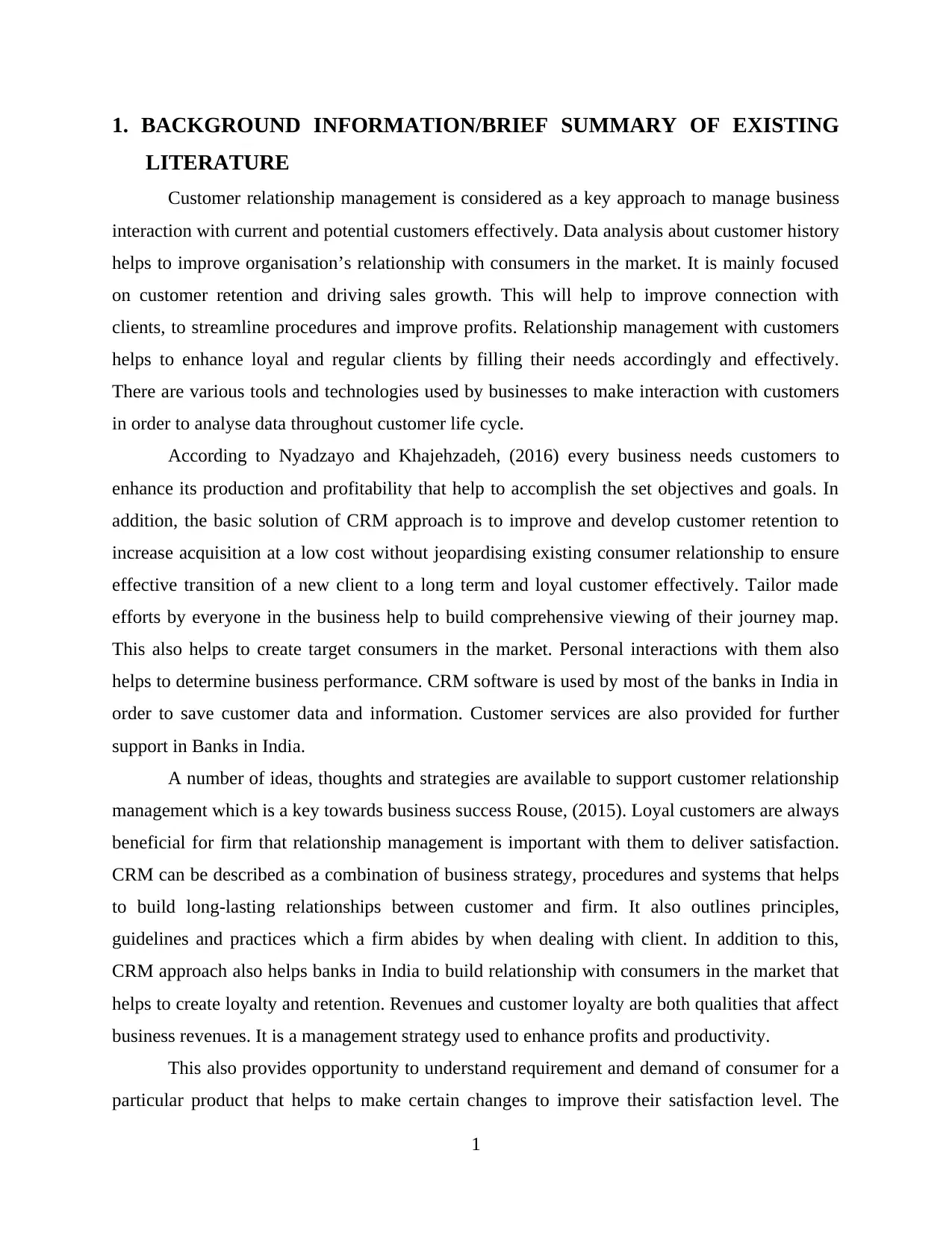
1. BACKGROUND INFORMATION/BRIEF SUMMARY OF EXISTING
LITERATURE
Customer relationship management is considered as a key approach to manage business
interaction with current and potential customers effectively. Data analysis about customer history
helps to improve organisation’s relationship with consumers in the market. It is mainly focused
on customer retention and driving sales growth. This will help to improve connection with
clients, to streamline procedures and improve profits. Relationship management with customers
helps to enhance loyal and regular clients by filling their needs accordingly and effectively.
There are various tools and technologies used by businesses to make interaction with customers
in order to analyse data throughout customer life cycle.
According to Nyadzayo and Khajehzadeh, (2016) every business needs customers to
enhance its production and profitability that help to accomplish the set objectives and goals. In
addition, the basic solution of CRM approach is to improve and develop customer retention to
increase acquisition at a low cost without jeopardising existing consumer relationship to ensure
effective transition of a new client to a long term and loyal customer effectively. Tailor made
efforts by everyone in the business help to build comprehensive viewing of their journey map.
This also helps to create target consumers in the market. Personal interactions with them also
helps to determine business performance. CRM software is used by most of the banks in India in
order to save customer data and information. Customer services are also provided for further
support in Banks in India.
A number of ideas, thoughts and strategies are available to support customer relationship
management which is a key towards business success Rouse, (2015). Loyal customers are always
beneficial for firm that relationship management is important with them to deliver satisfaction.
CRM can be described as a combination of business strategy, procedures and systems that helps
to build long-lasting relationships between customer and firm. It also outlines principles,
guidelines and practices which a firm abides by when dealing with client. In addition to this,
CRM approach also helps banks in India to build relationship with consumers in the market that
helps to create loyalty and retention. Revenues and customer loyalty are both qualities that affect
business revenues. It is a management strategy used to enhance profits and productivity.
This also provides opportunity to understand requirement and demand of consumer for a
particular product that helps to make certain changes to improve their satisfaction level. The
1
LITERATURE
Customer relationship management is considered as a key approach to manage business
interaction with current and potential customers effectively. Data analysis about customer history
helps to improve organisation’s relationship with consumers in the market. It is mainly focused
on customer retention and driving sales growth. This will help to improve connection with
clients, to streamline procedures and improve profits. Relationship management with customers
helps to enhance loyal and regular clients by filling their needs accordingly and effectively.
There are various tools and technologies used by businesses to make interaction with customers
in order to analyse data throughout customer life cycle.
According to Nyadzayo and Khajehzadeh, (2016) every business needs customers to
enhance its production and profitability that help to accomplish the set objectives and goals. In
addition, the basic solution of CRM approach is to improve and develop customer retention to
increase acquisition at a low cost without jeopardising existing consumer relationship to ensure
effective transition of a new client to a long term and loyal customer effectively. Tailor made
efforts by everyone in the business help to build comprehensive viewing of their journey map.
This also helps to create target consumers in the market. Personal interactions with them also
helps to determine business performance. CRM software is used by most of the banks in India in
order to save customer data and information. Customer services are also provided for further
support in Banks in India.
A number of ideas, thoughts and strategies are available to support customer relationship
management which is a key towards business success Rouse, (2015). Loyal customers are always
beneficial for firm that relationship management is important with them to deliver satisfaction.
CRM can be described as a combination of business strategy, procedures and systems that helps
to build long-lasting relationships between customer and firm. It also outlines principles,
guidelines and practices which a firm abides by when dealing with client. In addition to this,
CRM approach also helps banks in India to build relationship with consumers in the market that
helps to create loyalty and retention. Revenues and customer loyalty are both qualities that affect
business revenues. It is a management strategy used to enhance profits and productivity.
This also provides opportunity to understand requirement and demand of consumer for a
particular product that helps to make certain changes to improve their satisfaction level. The
1
⊘ This is a preview!⊘
Do you want full access?
Subscribe today to unlock all pages.

Trusted by 1+ million students worldwide
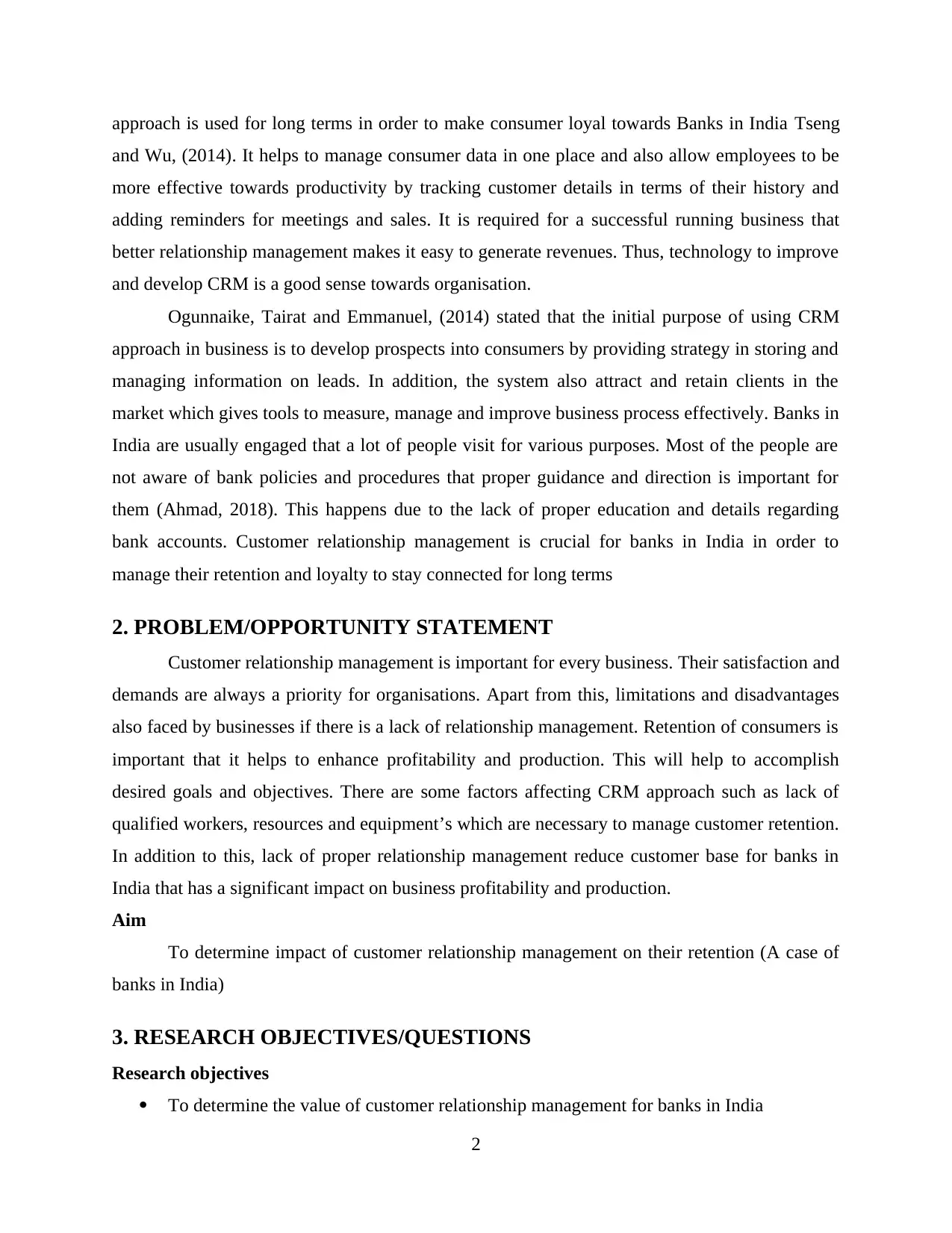
approach is used for long terms in order to make consumer loyal towards Banks in India Tseng
and Wu, (2014). It helps to manage consumer data in one place and also allow employees to be
more effective towards productivity by tracking customer details in terms of their history and
adding reminders for meetings and sales. It is required for a successful running business that
better relationship management makes it easy to generate revenues. Thus, technology to improve
and develop CRM is a good sense towards organisation.
Ogunnaike, Tairat and Emmanuel, (2014) stated that the initial purpose of using CRM
approach in business is to develop prospects into consumers by providing strategy in storing and
managing information on leads. In addition, the system also attract and retain clients in the
market which gives tools to measure, manage and improve business process effectively. Banks in
India are usually engaged that a lot of people visit for various purposes. Most of the people are
not aware of bank policies and procedures that proper guidance and direction is important for
them (Ahmad, 2018). This happens due to the lack of proper education and details regarding
bank accounts. Customer relationship management is crucial for banks in India in order to
manage their retention and loyalty to stay connected for long terms
2. PROBLEM/OPPORTUNITY STATEMENT
Customer relationship management is important for every business. Their satisfaction and
demands are always a priority for organisations. Apart from this, limitations and disadvantages
also faced by businesses if there is a lack of relationship management. Retention of consumers is
important that it helps to enhance profitability and production. This will help to accomplish
desired goals and objectives. There are some factors affecting CRM approach such as lack of
qualified workers, resources and equipment’s which are necessary to manage customer retention.
In addition to this, lack of proper relationship management reduce customer base for banks in
India that has a significant impact on business profitability and production.
Aim
To determine impact of customer relationship management on their retention (A case of
banks in India)
3. RESEARCH OBJECTIVES/QUESTIONS
Research objectives
To determine the value of customer relationship management for banks in India
2
and Wu, (2014). It helps to manage consumer data in one place and also allow employees to be
more effective towards productivity by tracking customer details in terms of their history and
adding reminders for meetings and sales. It is required for a successful running business that
better relationship management makes it easy to generate revenues. Thus, technology to improve
and develop CRM is a good sense towards organisation.
Ogunnaike, Tairat and Emmanuel, (2014) stated that the initial purpose of using CRM
approach in business is to develop prospects into consumers by providing strategy in storing and
managing information on leads. In addition, the system also attract and retain clients in the
market which gives tools to measure, manage and improve business process effectively. Banks in
India are usually engaged that a lot of people visit for various purposes. Most of the people are
not aware of bank policies and procedures that proper guidance and direction is important for
them (Ahmad, 2018). This happens due to the lack of proper education and details regarding
bank accounts. Customer relationship management is crucial for banks in India in order to
manage their retention and loyalty to stay connected for long terms
2. PROBLEM/OPPORTUNITY STATEMENT
Customer relationship management is important for every business. Their satisfaction and
demands are always a priority for organisations. Apart from this, limitations and disadvantages
also faced by businesses if there is a lack of relationship management. Retention of consumers is
important that it helps to enhance profitability and production. This will help to accomplish
desired goals and objectives. There are some factors affecting CRM approach such as lack of
qualified workers, resources and equipment’s which are necessary to manage customer retention.
In addition to this, lack of proper relationship management reduce customer base for banks in
India that has a significant impact on business profitability and production.
Aim
To determine impact of customer relationship management on their retention (A case of
banks in India)
3. RESEARCH OBJECTIVES/QUESTIONS
Research objectives
To determine the value of customer relationship management for banks in India
2
Paraphrase This Document
Need a fresh take? Get an instant paraphrase of this document with our AI Paraphraser
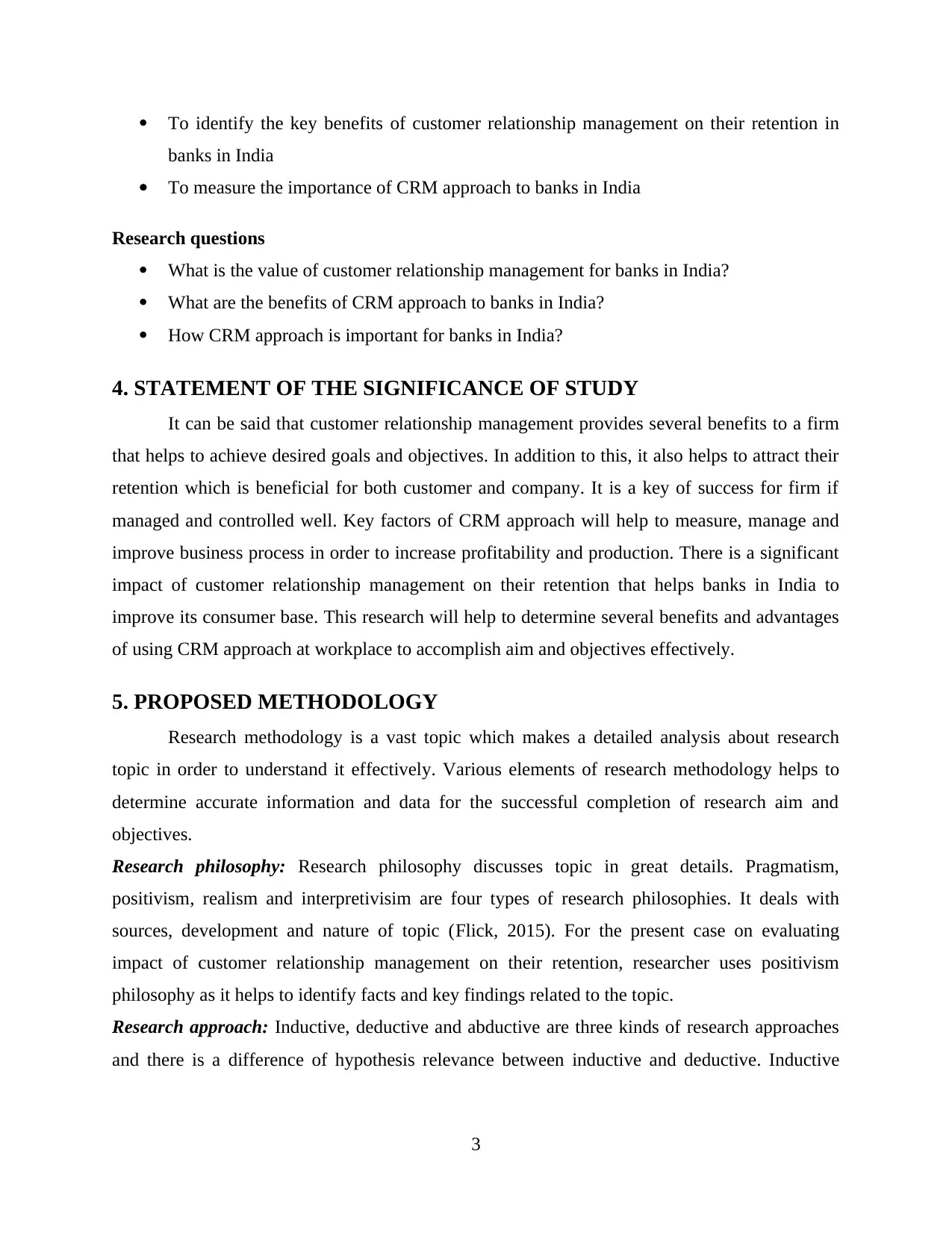
To identify the key benefits of customer relationship management on their retention in
banks in India
To measure the importance of CRM approach to banks in India
Research questions
What is the value of customer relationship management for banks in India?
What are the benefits of CRM approach to banks in India?
How CRM approach is important for banks in India?
4. STATEMENT OF THE SIGNIFICANCE OF STUDY
It can be said that customer relationship management provides several benefits to a firm
that helps to achieve desired goals and objectives. In addition to this, it also helps to attract their
retention which is beneficial for both customer and company. It is a key of success for firm if
managed and controlled well. Key factors of CRM approach will help to measure, manage and
improve business process in order to increase profitability and production. There is a significant
impact of customer relationship management on their retention that helps banks in India to
improve its consumer base. This research will help to determine several benefits and advantages
of using CRM approach at workplace to accomplish aim and objectives effectively.
5. PROPOSED METHODOLOGY
Research methodology is a vast topic which makes a detailed analysis about research
topic in order to understand it effectively. Various elements of research methodology helps to
determine accurate information and data for the successful completion of research aim and
objectives.
Research philosophy: Research philosophy discusses topic in great details. Pragmatism,
positivism, realism and interpretivisim are four types of research philosophies. It deals with
sources, development and nature of topic (Flick, 2015). For the present case on evaluating
impact of customer relationship management on their retention, researcher uses positivism
philosophy as it helps to identify facts and key findings related to the topic.
Research approach: Inductive, deductive and abductive are three kinds of research approaches
and there is a difference of hypothesis relevance between inductive and deductive. Inductive
3
banks in India
To measure the importance of CRM approach to banks in India
Research questions
What is the value of customer relationship management for banks in India?
What are the benefits of CRM approach to banks in India?
How CRM approach is important for banks in India?
4. STATEMENT OF THE SIGNIFICANCE OF STUDY
It can be said that customer relationship management provides several benefits to a firm
that helps to achieve desired goals and objectives. In addition to this, it also helps to attract their
retention which is beneficial for both customer and company. It is a key of success for firm if
managed and controlled well. Key factors of CRM approach will help to measure, manage and
improve business process in order to increase profitability and production. There is a significant
impact of customer relationship management on their retention that helps banks in India to
improve its consumer base. This research will help to determine several benefits and advantages
of using CRM approach at workplace to accomplish aim and objectives effectively.
5. PROPOSED METHODOLOGY
Research methodology is a vast topic which makes a detailed analysis about research
topic in order to understand it effectively. Various elements of research methodology helps to
determine accurate information and data for the successful completion of research aim and
objectives.
Research philosophy: Research philosophy discusses topic in great details. Pragmatism,
positivism, realism and interpretivisim are four types of research philosophies. It deals with
sources, development and nature of topic (Flick, 2015). For the present case on evaluating
impact of customer relationship management on their retention, researcher uses positivism
philosophy as it helps to identify facts and key findings related to the topic.
Research approach: Inductive, deductive and abductive are three kinds of research approaches
and there is a difference of hypothesis relevance between inductive and deductive. Inductive
3
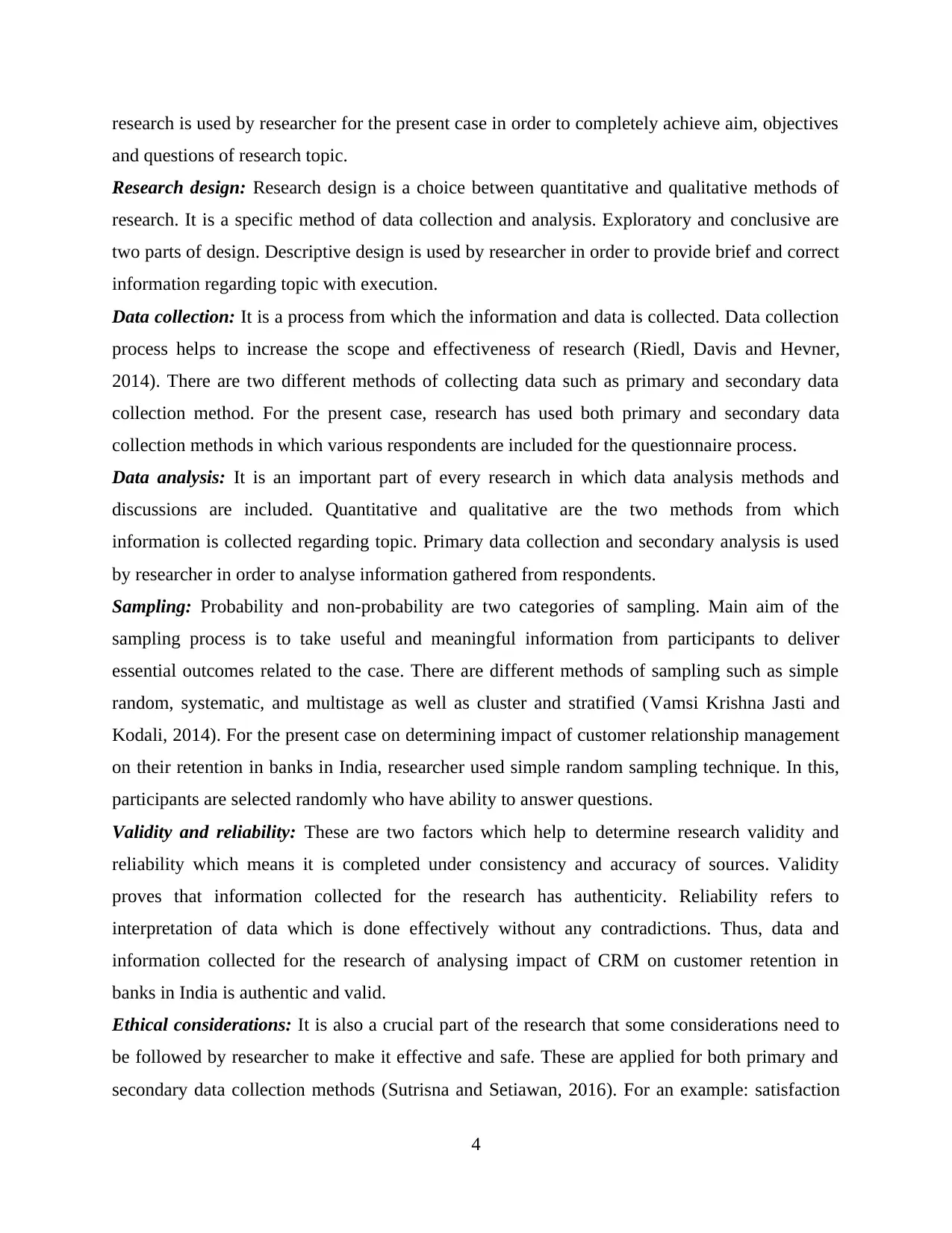
research is used by researcher for the present case in order to completely achieve aim, objectives
and questions of research topic.
Research design: Research design is a choice between quantitative and qualitative methods of
research. It is a specific method of data collection and analysis. Exploratory and conclusive are
two parts of design. Descriptive design is used by researcher in order to provide brief and correct
information regarding topic with execution.
Data collection: It is a process from which the information and data is collected. Data collection
process helps to increase the scope and effectiveness of research (Riedl, Davis and Hevner,
2014). There are two different methods of collecting data such as primary and secondary data
collection method. For the present case, research has used both primary and secondary data
collection methods in which various respondents are included for the questionnaire process.
Data analysis: It is an important part of every research in which data analysis methods and
discussions are included. Quantitative and qualitative are the two methods from which
information is collected regarding topic. Primary data collection and secondary analysis is used
by researcher in order to analyse information gathered from respondents.
Sampling: Probability and non-probability are two categories of sampling. Main aim of the
sampling process is to take useful and meaningful information from participants to deliver
essential outcomes related to the case. There are different methods of sampling such as simple
random, systematic, and multistage as well as cluster and stratified (Vamsi Krishna Jasti and
Kodali, 2014). For the present case on determining impact of customer relationship management
on their retention in banks in India, researcher used simple random sampling technique. In this,
participants are selected randomly who have ability to answer questions.
Validity and reliability: These are two factors which help to determine research validity and
reliability which means it is completed under consistency and accuracy of sources. Validity
proves that information collected for the research has authenticity. Reliability refers to
interpretation of data which is done effectively without any contradictions. Thus, data and
information collected for the research of analysing impact of CRM on customer retention in
banks in India is authentic and valid.
Ethical considerations: It is also a crucial part of the research that some considerations need to
be followed by researcher to make it effective and safe. These are applied for both primary and
secondary data collection methods (Sutrisna and Setiawan, 2016). For an example: satisfaction
4
and questions of research topic.
Research design: Research design is a choice between quantitative and qualitative methods of
research. It is a specific method of data collection and analysis. Exploratory and conclusive are
two parts of design. Descriptive design is used by researcher in order to provide brief and correct
information regarding topic with execution.
Data collection: It is a process from which the information and data is collected. Data collection
process helps to increase the scope and effectiveness of research (Riedl, Davis and Hevner,
2014). There are two different methods of collecting data such as primary and secondary data
collection method. For the present case, research has used both primary and secondary data
collection methods in which various respondents are included for the questionnaire process.
Data analysis: It is an important part of every research in which data analysis methods and
discussions are included. Quantitative and qualitative are the two methods from which
information is collected regarding topic. Primary data collection and secondary analysis is used
by researcher in order to analyse information gathered from respondents.
Sampling: Probability and non-probability are two categories of sampling. Main aim of the
sampling process is to take useful and meaningful information from participants to deliver
essential outcomes related to the case. There are different methods of sampling such as simple
random, systematic, and multistage as well as cluster and stratified (Vamsi Krishna Jasti and
Kodali, 2014). For the present case on determining impact of customer relationship management
on their retention in banks in India, researcher used simple random sampling technique. In this,
participants are selected randomly who have ability to answer questions.
Validity and reliability: These are two factors which help to determine research validity and
reliability which means it is completed under consistency and accuracy of sources. Validity
proves that information collected for the research has authenticity. Reliability refers to
interpretation of data which is done effectively without any contradictions. Thus, data and
information collected for the research of analysing impact of CRM on customer retention in
banks in India is authentic and valid.
Ethical considerations: It is also a crucial part of the research that some considerations need to
be followed by researcher to make it effective and safe. These are applied for both primary and
secondary data collection methods (Sutrisna and Setiawan, 2016). For an example: satisfaction
4
⊘ This is a preview!⊘
Do you want full access?
Subscribe today to unlock all pages.

Trusted by 1+ million students worldwide
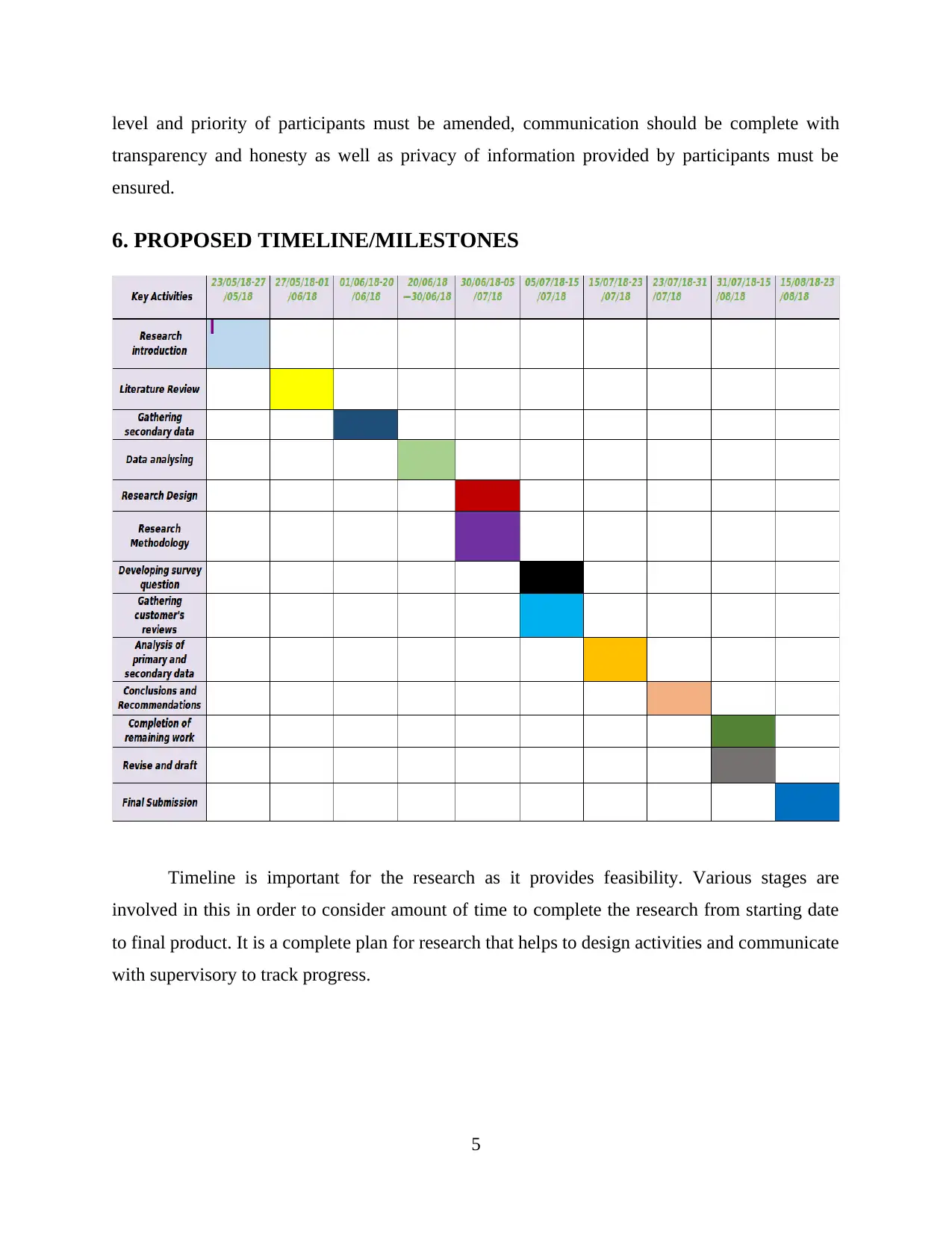
level and priority of participants must be amended, communication should be complete with
transparency and honesty as well as privacy of information provided by participants must be
ensured.
6. PROPOSED TIMELINE/MILESTONES
Timeline is important for the research as it provides feasibility. Various stages are
involved in this in order to consider amount of time to complete the research from starting date
to final product. It is a complete plan for research that helps to design activities and communicate
with supervisory to track progress.
5
transparency and honesty as well as privacy of information provided by participants must be
ensured.
6. PROPOSED TIMELINE/MILESTONES
Timeline is important for the research as it provides feasibility. Various stages are
involved in this in order to consider amount of time to complete the research from starting date
to final product. It is a complete plan for research that helps to design activities and communicate
with supervisory to track progress.
5
Paraphrase This Document
Need a fresh take? Get an instant paraphrase of this document with our AI Paraphraser
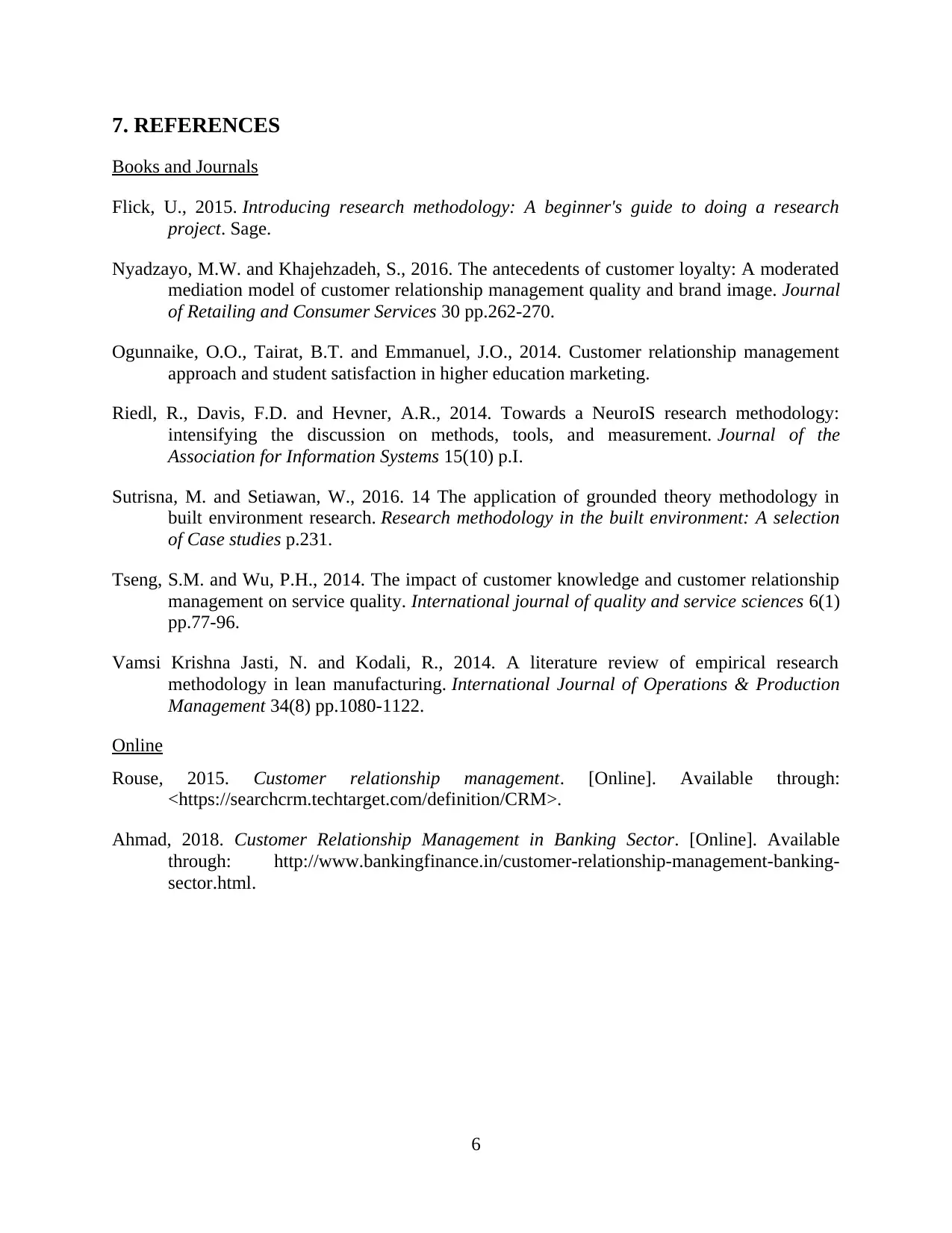
7. REFERENCES
Books and Journals
Flick, U., 2015. Introducing research methodology: A beginner's guide to doing a research
project. Sage.
Nyadzayo, M.W. and Khajehzadeh, S., 2016. The antecedents of customer loyalty: A moderated
mediation model of customer relationship management quality and brand image. Journal
of Retailing and Consumer Services 30 pp.262-270.
Ogunnaike, O.O., Tairat, B.T. and Emmanuel, J.O., 2014. Customer relationship management
approach and student satisfaction in higher education marketing.
Riedl, R., Davis, F.D. and Hevner, A.R., 2014. Towards a NeuroIS research methodology:
intensifying the discussion on methods, tools, and measurement. Journal of the
Association for Information Systems 15(10) p.I.
Sutrisna, M. and Setiawan, W., 2016. 14 The application of grounded theory methodology in
built environment research. Research methodology in the built environment: A selection
of Case studies p.231.
Tseng, S.M. and Wu, P.H., 2014. The impact of customer knowledge and customer relationship
management on service quality. International journal of quality and service sciences 6(1)
pp.77-96.
Vamsi Krishna Jasti, N. and Kodali, R., 2014. A literature review of empirical research
methodology in lean manufacturing. International Journal of Operations & Production
Management 34(8) pp.1080-1122.
Online
Rouse, 2015. Customer relationship management. [Online]. Available through:
<https://searchcrm.techtarget.com/definition/CRM>.
Ahmad, 2018. Customer Relationship Management in Banking Sector. [Online]. Available
through: http://www.bankingfinance.in/customer-relationship-management-banking-
sector.html.
6
Books and Journals
Flick, U., 2015. Introducing research methodology: A beginner's guide to doing a research
project. Sage.
Nyadzayo, M.W. and Khajehzadeh, S., 2016. The antecedents of customer loyalty: A moderated
mediation model of customer relationship management quality and brand image. Journal
of Retailing and Consumer Services 30 pp.262-270.
Ogunnaike, O.O., Tairat, B.T. and Emmanuel, J.O., 2014. Customer relationship management
approach and student satisfaction in higher education marketing.
Riedl, R., Davis, F.D. and Hevner, A.R., 2014. Towards a NeuroIS research methodology:
intensifying the discussion on methods, tools, and measurement. Journal of the
Association for Information Systems 15(10) p.I.
Sutrisna, M. and Setiawan, W., 2016. 14 The application of grounded theory methodology in
built environment research. Research methodology in the built environment: A selection
of Case studies p.231.
Tseng, S.M. and Wu, P.H., 2014. The impact of customer knowledge and customer relationship
management on service quality. International journal of quality and service sciences 6(1)
pp.77-96.
Vamsi Krishna Jasti, N. and Kodali, R., 2014. A literature review of empirical research
methodology in lean manufacturing. International Journal of Operations & Production
Management 34(8) pp.1080-1122.
Online
Rouse, 2015. Customer relationship management. [Online]. Available through:
<https://searchcrm.techtarget.com/definition/CRM>.
Ahmad, 2018. Customer Relationship Management in Banking Sector. [Online]. Available
through: http://www.bankingfinance.in/customer-relationship-management-banking-
sector.html.
6
1 out of 8
Related Documents
Your All-in-One AI-Powered Toolkit for Academic Success.
+13062052269
info@desklib.com
Available 24*7 on WhatsApp / Email
![[object Object]](/_next/static/media/star-bottom.7253800d.svg)
Unlock your academic potential
Copyright © 2020–2025 A2Z Services. All Rights Reserved. Developed and managed by ZUCOL.





